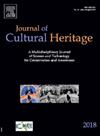邓熵与LSTM神经网络在严重破坏建筑文化遗产分类中的应用
IF 3.5
2区 综合性期刊
0 ARCHAEOLOGY
引用次数: 0
摘要
提出了一种严重和极严重破坏的独特建筑文化遗产结构状态的三维自动识别方法。为此,使用了映射到建筑文化遗产体素的3D重建(点云)。然后,对得到的体素图计算邓熵,并应用盒覆盖法获得相应的信息维数。将熵和信息维数据序列组合成一个序列,称为邓序列。这是为了量化建筑文化遗产体素地图的占用空间。采用邓氏序列作为双向长短期记忆神经网络(bLSTMnn)的输入,对建筑文化遗产的结构状态进行自动分类。主要考虑的是,由于建筑文化遗产的独特性,可供使用的模型很少。因此,作者使用计算机辅助设计工具创建了一个小数据集,用于训练bLSTMnn。采用交叉方法对bLSTMnn进行了验证。所提出的方法被成功地应用于识别一个独特的墨西哥文化遗产建筑的当前结构状态,该建筑受到了非常严重的破坏。本文章由计算机程序翻译,如有差异,请以英文原文为准。

Deng entropy and LSTM neural network to classify built cultural heritage with severe damage
This paper proposes an automatic approach for the 3D recognition of the structural state of uniquely built cultural heritage with severe and very severe damage. For this purpose, a 3D reconstruction (point cloud) mapped to voxels of built cultural heritage is used. Then, Deng entropy is computed for the resulting voxel map, and the corresponding information dimension is obtained by applying the box-covering method. The entropy and information dimension data sequences are combined into one sequence, called the Deng sequence. This is in order to quantify the occupied space in voxel map of built cultural heritage. Deng sequence is used as the input for a bidirectional Long Short-Term Memory neural network (bLSTMnn) to automatically classify the structural state of built cultural heritage. The main consideration is that few models of built cultural heritage are available due to their uniqueness. Hence, a small dataset created by authors using Computer-Aided Design tools is used for the training of the bLSTMnn. A cross-method is applied to validate the bLSTMnn. The proposed approach is successfully applied to recognize the current structural state of a unique Mexican cultural heritage building with very severe damage.
求助全文
通过发布文献求助,成功后即可免费获取论文全文。
去求助
来源期刊

Journal of Cultural Heritage
综合性期刊-材料科学:综合
CiteScore
6.80
自引率
9.70%
发文量
166
审稿时长
52 days
期刊介绍:
The Journal of Cultural Heritage publishes original papers which comprise previously unpublished data and present innovative methods concerning all aspects of science and technology of cultural heritage as well as interpretation and theoretical issues related to preservation.
 求助内容:
求助内容: 应助结果提醒方式:
应助结果提醒方式:


